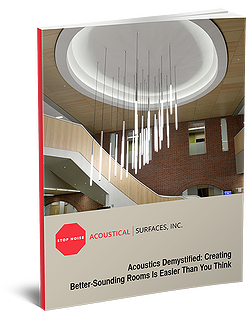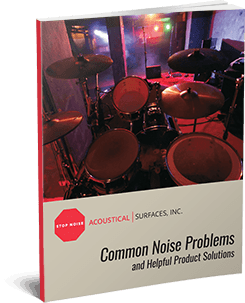How to Soundproof Stairs: A Step-by-Step Guide to Reducing Stairway Noise
If you’ve ever been woken up by heavy footsteps pounding up the stairs or annoyed by squeaks or rumbles echoing through a stairwell, you already know how much stair noise can disrupt daily life. Stairs are often overlooked when people think about soundproofing, but they can be one of the biggest weak points in a building’s acoustic design. Whether you’re dealing with impact noise from footsteps, squeaky wood framing, echo in an open stairwell, or even elevator shaft noise next to a stairway, learning how to soundproof stairs is a smart investment in comfort and privacy.
Noise issues around staircases show up in both residential and commercial spaces. Here are the types you need to know about when planning your soundproofing strategy, as well as some examples of these noise types in staircases:
- Impact Noise: Heavy footsteps, heels, or kids running up and down the stairs.
- Structure-Borne Noise: Squeaky joints or loose stair treads.
- Airborne Noise: Echoes in tall stairwells, or voices carrying between floors.
- Mechanical Noise: Humming, rumbling, or vibrations from nearby elevator shafts or mechanical rooms.
The good news? With the right combination of materials and techniques, you can tackle all of these problems. Let’s walk through the best strategies step by step.
1. Add Carpet and Underlayment to Absorb Footfall Noise
One of the simplest ways to quiet a staircase is to soften the blow of footsteps. Bare wood or tile stairs can act like a drum, amplifying every step. Adding carpet for noisy stairs can make a dramatic difference.
- Choose a dense, high-pile carpet that can absorb impact noise instead of bouncing sound back into the space.
- Pair it with a quality acoustic underlayment (foam rubber or felt padding) for added cushion and sound reduction.
- If you don’t want full carpeting, a stair runner with anti-slip backing is a good compromise, as it dampens sound while maintaining the look of your wood stairs.
This type of stair tread soundproofing is especially effective in multi-story homes, apartments, or commercial buildings where stair noise transfers between levels. If you’ve been wondering how to stop footstep noise without a major remodel, starting with carpet and underlayment is one of the most straightforward fixes.
2. Use Acoustic Panels on Stairwell Walls
Even if you fix footstep noise, open staircases can still echo like crazy. That’s where wall panels for staircase echo come in. Adding acoustic treatment to the stairwell walls absorbs airborne noise and reduces the “megaphone effect” of tall, open spaces.
You have a range of panel options:
- Fabric-wrapped panels for soft absorption that can double as artwork.
- PET or recycled felt panels for eco-friendly performance.
- Perforated wood panels for a more architectural finish.
In homes and offices alike, panels can double as design features. In commercial settings, look for fire-rated or impact-resistant panels. Panel placement in stairwells isn’t overly picky–panels work as long as they’re on exposed wall surfaces, so installing them slightly out of reach helps them last longer.
3. Seal Gaps and Cracks in Stair Construction
Even small gaps or cracks can act like leaks, letting sound travel freely between floors. That’s why sealing them is such an important step in creating more soundproof stairs.
- Run a bead of acoustic caulk (the best sealant for stair noise) along stair stringers, trim, and molding.
- Check for gaps where the stairs meet the walls or floor.
- Don’t forget to seal under stair nosing if the underside is exposed.
This step alone won’t solve all your noisy stair issues, but if you skip it, other upgrades won’t perform as well. Think of it as plugging holes in a soundproof “bucket.”
4. Add Acoustic Insulation Behind or Beneath Stairs
If the space beneath or around the stairs is open, you’ve got an opportunity for a serious noise reduction upgrade. Installing acoustic insulation for stairs reduces airborne noise transmission.
Options include:
- Filling under stair insulation cavities with mineral wool or fiberglass batts.
- If the stairs are above finished rooms, insulate the underside from the basement or crawlspace.
- For maximum performance, build a staircase enclosure acoustic system with resilient channels and double layers of drywall. When using double layers of drywall, always make sure the structure is strong enough to handle the added weight.
This type of treatment is perfect for new builds but can also be done as a retrofit if you have access to the underside of the stair structure.
Read More: Retrofitting Walls and Floor/Ceiling Assemblies Using RSIC-1 Sound Isolation Clips
5. Install or Upgrade Stairway Doors for Better Isolation
Doors at the top or bottom of staircases play a huge role in controlling noise between floors. Unfortunately, most homes and apartments have cheap hollow-core doors that barely block sound.
Here’s how to improve stairway isolation:
- Replace hollow-core doors with solid-core doors. Solid-core door soundproofing upgrades block substantially more sound than hollow-core doors.
- Install acoustic door seal kits (perimeter seals and automatic door bottoms) to stop sound leaks around the frame.
- Pair the door upgrade with MLV sound barrier sheets for even better isolation.
A properly sealed solid-core door can be the difference between hearing conversations on every floor and having real privacy.
6. Eliminate Squeaky Stairs for Peace and Quiet
Few noises are as irritating as a squeaky stair. These squeaks are usually the result of loose joints or wood-on-wood friction. If you want to fix squeaky stairs permanently, you’ll need to reinforce the structure.
- When building or renovating, always use screws and construction adhesive instead of nails.
- Add glue blocks or metal brackets under treads and risers for extra rigidity.
- Tighten or replace worn wedges in older staircases.
- Apply adhesive or sealant where wood rubs against wood.
These fixes stop the tiny movements that create squeaks and creaks. Pair this with stair tread insulation and you’ll knock out two noise problems at once.
7. Consider Full Staircase Enclosure for Maximum Control
If you’re dealing with a particularly noisy stairwell–especially in multi-unit or commercial buildings–the best solution may be to enclose the staircase.
A staircase enclosure acoustic upgrade involves:
- Framing new walls around the stairwell.
- Filling them with acoustic insulation.
- Using decoupling techniques like resilient channels and RSIC clips to block vibration transfer.
- Finishing with double drywall for a more soundproof staircase wall and fabric-wrapped wall panels for staircase echo reduction.
This is a larger project, but it transforms an open echo chamber into a controlled acoustic space. It’s worth considering in the planning stage of any stairwell construction project.
8. Blocking Mechanical and Elevator Noise Near Stairwells
Sometimes the noise problem isn’t footsteps at all–it’s noise coming from adjacent rooms. If your stairs share a wall with an elevator shaft or mechanical room, you’ll need a different approach.
For elevator shaft noise reduction or to create a sound barrier for mechanical room setups, try:
- Building double walls with air gaps between the stairwell and noise source.
- Using RSIC-1 sound isolation clips and resilient channel to decouple drywall from framing.
- Placing springs or vibration isolation mounts under heavy mechanical equipment to cut down low-frequency rumble (springs are more effective than basic rubber pads, but pads are better than nothing).
These techniques are often used in commercial spaces, but they’re equally valuable in high-end residential projects where mechanical noise is a problem.
Final Thoughts: Combining Treatments for Best Results
When it comes to staircase noise, there’s no single “magic fix.” Stairs transmit multiple types of sound–footsteps, squeaks, echoes, and even rumble from nearby mechanical spaces–so the best results come from layering solutions. Think of it like building an acoustic shield: each treatment blocks or absorbs a different type of noise, and together they create a much quieter environment.
For impact noise, carpet for noisy stairs paired with a dense underlayment remains one of the most effective and affordable options. In many cases, a purpose-designed noise reduction stair tread can also be installed to provide targeted cushioning and help tame the sharp impact sounds of heavy footsteps. Tackling structural noise is equally important–if your steps squeak, learning how to fix squeaky stairs permanently with screws, glue blocks, and construction adhesive can eliminate the problem at the source. For airborne issues, consider a combination of stair tread soundproofing, under stair insulation, and wall panels for staircase echo. These not only dampen sound but also improve the overall acoustic comfort of your space.
In stairwells that double as sound conduits between floors, solid-core door soundproofing and proper seals are game changers. If your building allows, a staircase enclosure acoustic upgrade is the gold standard–essentially transforming an open echo chamber into a controlled and insulated sound barrier. And in commercial or multi-unit settings, addressing specialized challenges like elevator shaft noise reduction or building a sound barrier for mechanical rooms is often the difference between a constant background hum and true peace and quiet.
Ultimately, the path you choose depends on your space, your budget, and your tolerance for noise. Some people just need a softer step; others want full acoustic isolation. The good news is that modern materials and installation methods make it easier than ever to treat staircases as seriously as walls, ceilings, and floors.
If you are planning to soundproof stairs in your home, office, or multifamily building, don’t go it alone. Contact an Acoustical Surfaces Inc. team member for expert guidance and proven acoustic products. With the right layered approach, you’ll enjoy a quieter, more comfortable environment for years to come.








